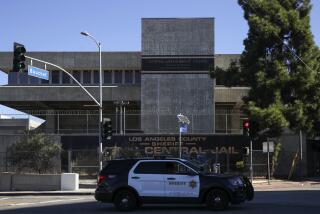Death chamber project criticized
SACRAMENTO — In an effort to persuade a judge to allow executions to resume in California, the administration of Gov. Arnold Schwarzenegger recently began quietly building a new death chamber at San Quentin State Prison.
The move, intended to address the court’s concern that putting prisoners to death in the existing cramped, dim chamber was cruel and unusual punishment, drew a sharp rebuke Friday from legislators who oversee corrections spending. They were not consulted on the project.
Legislators learned by accident this week that construction of the chamber was well underway when a couple of legislative policy analysts visited the prison for research and happened upon the new facility.
“It is an insult to the Legislature. It is an insult to the public,” Sen. Gloria Romero (D-Los Angeles) said. “It really is outrageous what they have done.”
Administration officials say that they did everything by the book. Legislative approval, they note, is required for projects costing $400,000. The administration priced the new chamber at $399,000.
Department of Corrections spokesman Seth Unger said the administration has been racing to make progress on the chamber by a May 15 deadline. That’s when it must report to U.S. District Judge Jeremy D. Fogel on how the state proposes to fix an execution system after a December ruling in which he said it was broken.
“We wanted to meet the May 15 deadline,” Unger said. “Our facilities management team took a look and judged they can do it using the minor capital outlay system” -- the provision of state law that allows departments to make expenditures of less than $400,000 without legislative approval.
Unger declined to provide details about what the state is constructing; he said the information will be disclosed in the May 15 report.
But Dan Carson, one of the legislative analysts who saw the facility during a visit Tuesday, said he was surprised to see that the project was very far along.
“They had it through the framing stage,” he said. “We were able to walk inside and get a sense of the spaces.... It was a surprise to us. We had not heard this was going on. We discovered it when we were there.”
Carson said the prison employees pointed out the problems with the old space -- the bad lighting, the cramped cell, the poorly designed and crowded witness room where family of the condemned sit shoulder to shoulder with representatives from the media and others. Then the employees escorted him and a colleague to the new area, where they explained how the problems are being addressed.
Carson said the new facility is “fairly expansive,” about twice the size of the old space. There are three rooms for witnesses, more space behind the chamber where the prison official conducting the execution prepares the injection, and a larger cell where the inmate can meet with a spiritual advisor in the minutes before being put to death.
In the old chamber, Carson said, lighting was a problem because “they had a tendency to turn down the lights to shield the person carrying out the execution from being visible to the witnesses.” Referring to the executioners, he said: “That arrangement makes it difficult, I would think, for them to see what they are doing.”
The new chamber appeared to be designed so the identity of the official making the injection could be shielded without dimmed lights.
Carson said his office is researching the project’s cost.
James Tilton, secretary of the California Department of Corrections and Rehabilitation, acknowledged the project when questioned by Sen. Michael Machado (D-Linden) at a routine legislative budget oversight hearing Thursday.
“Given the nature of this, the sensitivity of this, I thought we should have had the courtesy of being notified, even though it didn’t meet the criteria” that triggers legislative review, Machado said Friday. “This is another example where I think there has been a lack of transparency on the part of the administration” concerning prisons.
The judge’s ruling declaring the state’s executions cruel and unusual came in a case filed by inmate Michael Morales, who was sentenced to death more than 20 years ago for murdering Terri Winchell, a Lodi teenager.
David Senior, a defense attorney for Morales, said he learned about the construction from reporters Friday.
State officials, Senior said, “have made it very clear since the onset that transparency is the last thing they want.”
*
jordan.rau@latimes.com
For exclusive Web features, including the new Political Muscle blog, go to latimes.com/calpolitics.
More to Read
Get the L.A. Times Politics newsletter
Deeply reported insights into legislation, politics and policy from Sacramento, Washington and beyond. In your inbox three times per week.
You may occasionally receive promotional content from the Los Angeles Times.











